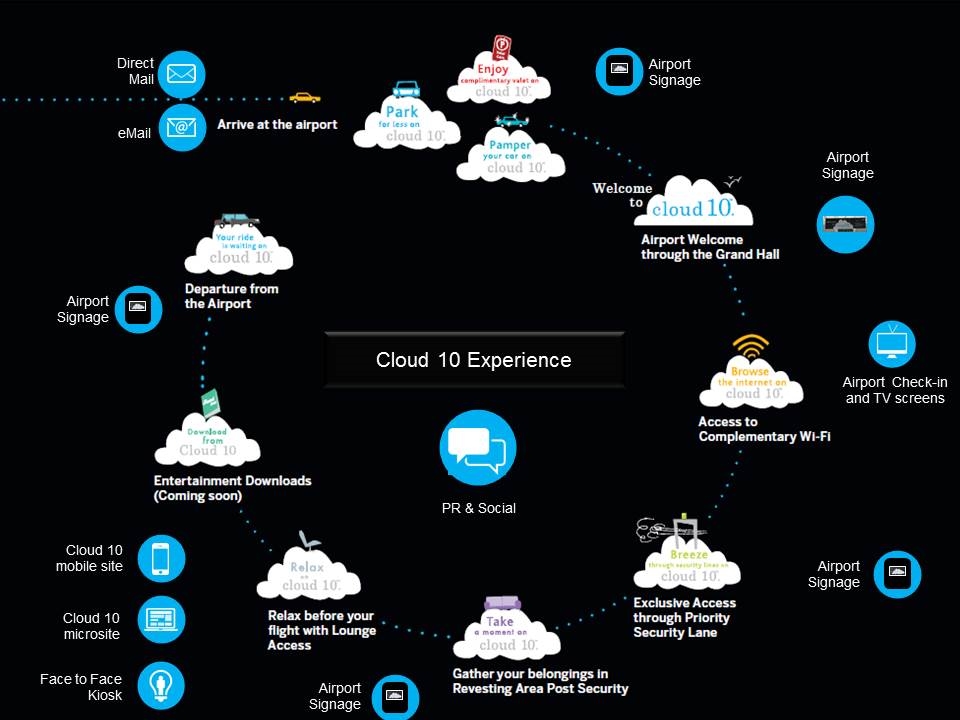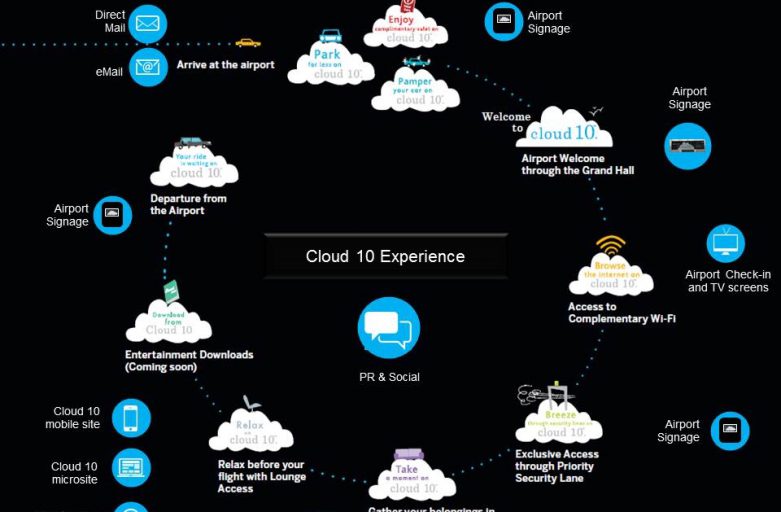Cloud 10 – Revitalizing the Airport as an acquisition channel
Off to a Good Start (GOLD)
Best Matching of Message to Medium(s) (GOLD)
Client Credits: American Express Canada
David Barnes, American Express Canada
Tina Santoro, American Express Canada
Stephanie Cisneros, American Express Canada
Christopher Vadori, American Express Canada
Aileen Kheraj, American Express Canada
Tim Elgar, American Express Canada
Michael Ross, Greater Toronto Airport Authority
Agency Credits: Ogilvy & Mather
Alex Furrer, Ogilvy & Mather
Jo Palmiero, Ogilvy & Mather
Katherine Palumbo, Ogilvy & Mather
Lynette Whiley, Mindshare
Neil Johnson, High Road Communications
Keith Baguley, BT/A Advertising
CCO: Matt Hassell, Alex Furrer
Associate Creative Director: Jamie George
Art Directors: Stefan D’Aversa, Fady Sbeih
Copywriter: Phil Coulter
Section I — BASIC INFORMATION
| Business Results Period (Consecutive Months): | September 2012 to July 2013 |
| Start of Advertising/Communication Effort: | September 2012 |
| Base Period as a Benchmark: | January 2012 – August 2013 |
Section II — SITUATION ANALYSIS
a) Overall Assessment
“The definition of insanity is doing the same thing over and over and expecting different results.” – Albert Einstein
Platinum Card losing its luster
American Express’s premium card franchise had been lagging in Canada for some time. The reasons were several: slow but steady increases in our annual fees; intensifying competitive card offers with me-too benefits and impressive media spends; and a perceptual weakening of the historic link between American Express and premium travel value. The result was all too clear: a steady weakening of Platinum Card applications.
Of immediate concern, the annual fee on the Platinum product was set to increase by a whopping 75% in June 2012 (rising from $399 to $699). Amex needed to protect its base of high-margin customers while reversing the decline in applications by attracting valuable new prospects at a faster clip than the brand was doing currently. It had long relied on the Airport channel as the perfect instrument for this sort of task: Canada’s largest travel hub, Toronto Pearson International Airport, sees 35 million people flowing through each year and premium travel cardholders are typically high spending, affluent customers.
The urgent business need and the tool identified to solve it were clear; there was just one problem… the channel was up to its knees in marketing clutter. Every major card issuer (including ourselves) had long approached this crucial sales channel in exactly the same way, so we knew we had to do it differently if we were expect different results.
b) Resulting Business Objectives
Our objectives, key performance indicators, and goals were as follows:
1. Business objective: Reverse the decline and build the Platinum Card franchise.
KPI: Platinum Card applications.1
Goal: Boost monthly Platinum card applications by 20%.
Do this by…
2. Brand objective: Restore the historic brand association between
American Express and premium travel experiences.
KPI: Amex Brand Tracker.
Goal: A lift of at least 10% for key brand metrics tied to this theme.
1 American Express Proprietary results data: Platinum Card Applications, Jan. 2012 to July 2013
c) Annual Media Budget
$3 – $4 million
d) Geographic Area
Greater Toronto Area: Pearson International Airport
Section III — STRATEGIC THINKING
a) Analysis and Insight
As we alluded to, despite the obvious appeal of the traveler target, American Express and every other major credit card issuer in Canada marketed itself in the airport in the same unimaginative way: glossy pictures of travel cards adorned airport billboards, while brightly dressed sales reps armed with clipboards interrupted harried travellers with the same question: ”Excuse me, do you have a minute?”
Dominated by static advertising and face-to-face selling techniques, it shouldn’t surprise us that investments in this channel were delivering diminishing returns.
So when the Greater Toronto Airport Authority (GTAA) invited Amex to pitch for preferred partner status, we knew the conventional approach wasn’t going to work. We had to do more than simply get our target to see our offer; we had to somehow help them feel it.
We headed to the airport to better understand the traveller’s experience and identify pain points along the journey. We spent time in parking garages, elevators, security lines, a variety of lounges, terminal gates, and taxi queues, giving us ample opportunities to observe the prevailing mood and absorb its energy. In short, we wound up feeling a bit…cranky.
And this led to our driving insight: Travel is a colossal drag, enlivened only by the sparks of preferential treatment (or the pangs of resentment), conferred by loyalty club status.
In general, travellers can do little to better their status while waiting in the airport; in fact, the average 2.5 hours spent there can be the most unfulfilling – not to say stressful – part of their journey.
b) Communication Strategy
Our opportunity was to activate Cardmember envy among prospects by flagging the benefits of American Express membership and its ability to confer preferential service right there, in the airport.
Doing that meant re-tracing the steps of our initial research journey at the airport and identifying specific times and places where a traveller’s stress and anxiety levels were at a peak. We found plenty; from navigating the cavernous parking lot upon arrival to waiting in the seemingly never-ending security line to getting trapped without WiFi and having to aimlessly count the seconds go by till boarding.
Ultimately it was these moments of truth that became perfect opportunities where American Express could help our target prospects feel the benefits of membership where they’d appreciate it most.
Section IV — KEY EXECUTIONAL ELEMENTS
a)Media Used

b)Creative Discussion
Welcome to Cloud 10
To activate envy and illustrate the unique benefits and privileges American Express offered we created the “Cloud 10” platform.
We did this:
For prospects:
By offering all travellers through Toronto Pearson International Airport access to free WiFi and branded rest areas beyond security checkpoints, where they could find a comfortable seat and spend a few moments gathering themselves before moving on.
For Cardmembers:
Special treatment that was amplified to enviable new heights, including:
Complimentary valet parking services;
Exclusive taxi and limo privileges;
Access to premium lounges;
…and the coup de grâce: exclusive Priority Security Lane access!
For prospects envying Cardmembers:
Throughout the airport, “Cloud 10” signage flagged site-specific services, so prospects couldn’t miss the special treatment that Amex Cardmembers were receiving in the line next to them.
Ever at the ready to convert their Cardmember envy, sales kiosks highlighted membership benefits specific to the airport, while WiFi log-in screens enabled immediate applications (and further re-targeting opportunities).
From end to end, “Cloud 10” was an immersive display of the benefits of membership, purposefully planted at several of the most critical pain points in the traveller’s journey.
c)Media Discussion
Inside the airport the role of media was to circle around the pain points/areas where “Cloud 10” was offering a better, less stress-inducing experience and ensure everyone knew it was coming from American Express. That meant leveraging existing airport signage, but also in some cases creating some that hadn’t previously existed to the partnership.
Out of the airport we created Amexcloud10.ca to support the initiative. The site shared information about benefits at the airport and contained a link to the featured Amex Platinum Card, so prospects could learn more about the product and apply directly.
We also leveraged the Amex Facebook and Twitter channels which were a natural fit for amplifying positive “Cloud 10” Cardmember experiences and getting prospects wishing and wanting to be a part of the “Cloud 10” experience when they travelled through Pearson.
Section V — BUSINESS RESULTS
a) Sales/Share Results
We beat our business objective
We not only reversed a declining trend in Platinum Card applications, but were able to actually increase applications by 51% YTD vs. forecast.
We beat our brand objectives

The data shows that prospects are now linking Amex with precisely the sort of premium travel experience that’s needed to make the value proposition resonate with our high-margin travel target.
Finally, “Cloud 10” delivered an exceptional return on marketing investment (ROMI): The program returned $2.74 to Amex for every $1.00 that was invested in it.[2]
[1] American Express Proprietary results data: Platinum Card Applications, Jan. 2012 to July 2013
[2] Amex calculates ROMI by taking the lifetime value of cardholders directly acquired in the channel and subtracting the total cost of the sponsorship and related marketing costs.
b) Consumption/ Usage Results
c) Other Pertinent Results
d) Return on Investment
Section VI — CAUSE & EFFECT BETWEEN ADVERTISING AND RESULTS
a)General Discussion
The best testament to the efficacy of the “Cloud 10” campaign is by comparing the applications we generated during our business results period (BRP) to those that would have been generated had their downward trend continued.
The chart below illustrates this impact and the fact that we not only reversed the declining application trajectory but also were able to increase applications by 51% during our BRP vs. the forecast based on trend.
These results were achieved with essentially all marketing investment being equal to prior comparable periods within the airport channel. The only incremental investment being the partnership costs, which were essentially used to fund the added value services versus incremental advertising communications.
A final testament to the effectiveness of our “Cloud 10” efforts is the fact that we were able to deliver this positive uptake in applications despite a radical fee increase of 75% from $399 to $699 for the Platinum Card taking effect in June 2012, shortly before the “Cloud 10” campaign launched.
b)Excluding Other Factors
Spending Levels:
Marketing budget was comparable to the marketing budget in previous years but the partnership costs were net new.
Pricing:
As we said, the fee for Platinum Card increased from $399 to $699 In June 2012, shortly before the campaign launched.
Distribution Changes:
The airport has been a key acquisition channel for American Express for several years. In Toronto Pearson the acquisition presence has been limited to 2 acquisition Kiosks. Within “Cloud 10” that presence did not change. We did however as mentioned create an online acquisition microsite in addition to this physical presence.
Unusual Promotional Activity:
Traditional social and PR channels were used to announce the launch of “Cloud 10” in the airport in 2012. There was no additional promotional activity within the airport or outside the airport to amplify the message.
Other Potential Causes:
N/A
